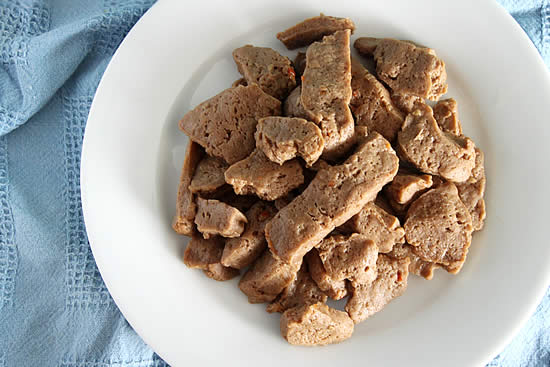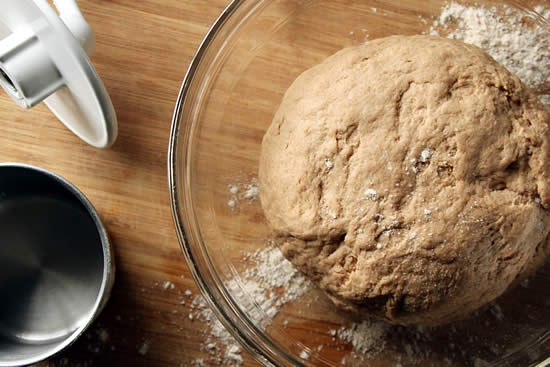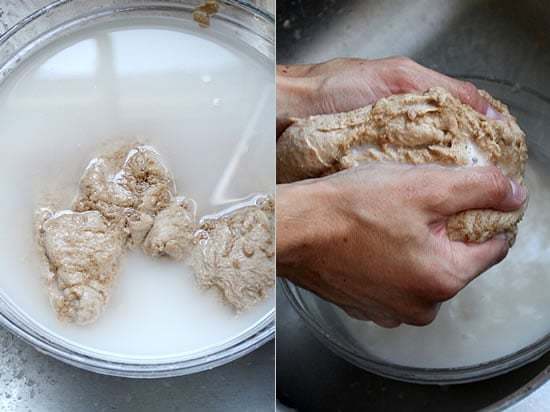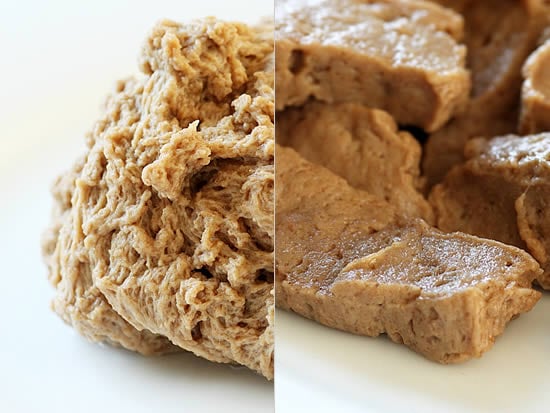Cooking with Seitan, the wheat meat. An Introduction.
Seitan, or seasoned wheat gluten, is a highly nutritious, protein-rich food that can be
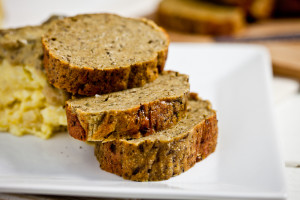
Sliced Roast Seitan
quickly and easily prepared in a variety of interesting ways. Although not widely known in the West, seasoned wheat gluten was traditionally eaten in China, Korea, Japan, Russia, the Middle East, and probably other countries that grew wheat. Seasoned wheat gluten is also associated with the dietary habits of religious groups such as Buddhists, Mormons, and Seventh Day Adventists. Seitan is a Japanese word that usually refers to wheat gluten that has been simmered in a broth of soy sauce and kombu. In the West seitan is often flavored with rosemary, ginger and even black pepper to give it additional flavor and familiarity. Seitan is amazingly meat-like in texture, with a delicious, savory flavor that makes it a very appealing and versatile vegetarian source of protein.
Seitan is made the traditional way by kneading whole wheat dough to develop the gluten, rinsing the dough to remove the starch (carbohydrates) and bran, thus concentrating the gluten (protein) of the wheat, and finally simmering the gluten in a savory broth. Seitan is not difficult to make at home, but the process is labor intense and rather messy. Making delicious seitan in a small shop requires a great deal of experience and some simple equipment.
Wheat is preeminent among the grains,because it is the only one whose endosperm protein interacts to form a gluten strong enough to bind together into a tight mass. Gluten is both plastic and elastic; that is, it will both change its shape under pressure and tend to reassume its original shape when pressure is removed. It is this elastic and plastic property of wheat gluten that is utilized during the seitan making process.
At the shop workers first place several hundred pounds of high gluten, whole wheat flour in the seitan or gluten machine. This is a stainless steel tank with several rotating arms or paddles at the bottom. Next, the machine is turned on while a specific amount of water is added. When wheat flour is mixed with water, the gluten protein begins to unfold into a random network. Water molecules separate and lubricate the long chains of gluten, which begin to stick together to form visible strands. Meanwhile, the wheat bran and starch turn the water into a milky beige slurry which is carefully discharged from the bottom of the seitan machine. (The liquid is saved and used as animal feed or to make other related foods.) Fresh water is added and drained several times as the constant motion of the paddles keeps concentrating the wheat gluten as it sticks together into a large, rubbery mass at the bottom of the seitan machine. Finally, after a few hours of mixing and several rinsings with fresh water, the concentrated gluten mass is removed from the machine, cut up into small pieces and cooked in a savory broth of kombu and soy sauce. The seasoned gluten is then packed in jars which are placed in a large pressure cooker (retort) and cooked for a specific time to ensure sterilization.
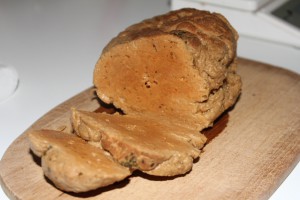
Sliced Roast Seitan
Nutritionally, seitan is a powerhouse. In both quantity and quality, the protein in seitan is similar to that in beef. Sirloin steak and seitan both supply approximately 16 grams of protein per 100-gram (3.5 once) serving, or about 25 percent of the U.S. Reference Daily Intake. This is twice as much as an equal amount of tofu and 40% more than is supplied by two medium eggs. Although unseasoned seitan, raw wheat gluten, is low in one essential amino acid, lysine, this is easily offset by cooking it in soy sauce-seasoned broth, or by combining or serving it with lysine-rich foods such as beans. And while the 3.5-ounce sirloin comes with 11.5 grams of saturated fat, 58 milligrams of cholesterol, and nearly 300 calories, seitan contains no saturated fat or cholesterol, and only 120 calories per 3.5-ounce serving.
In recent years, fish and seafood have been touted as the optimal low-fat, low-cholesterol, high-protein replacement for red meat. More and more reports, however, are cropping up warning of the dangers of eating fish because of the huge quantities of industrial and agricultural chemicals, toxic metals, garbage, and raw sewage being dumped into the fishes’ habitat. Toxic metals and contaminants such as lead, arsenic, methyl mercury polychlorinated biphenylis ( PCBs), DDT ,and chlordane have shown up in high concentrations in freshwater fish and seafood samples. Seitan is a clean, safe way to get high quality protein.
High in protein and essential amino acids, seitan made with whole wheat flour and cooked

Breaded Seitan
in a kombu and soy sauce broth is a good source of some vitamins and minerals. A four-ounce serving of seitan supplies between 6 and 10 percent of the U.S Reference Daily Intake of vitamin C, thiamin, riboflavin, niacin, and iron.
The factors that affect the quality of seitan are the choice of ingredients and the subtle aspects of the manufacturing process itself. Since seitan is mostly wheat gluten, the choice of wheat is particularly important. Mitoku’s seitan manufacturer uses only hard winter wheat, which has more protein than soft wheat. The choice of shoyu, which is the main flavor component of seitan, is very important. Our producer uses only whole soybean, naturally aged shoyu, which imparts a rich flavor and meat-like character to seitan. Finally, the addition of kombu to the cooking broth not only adds important minerals, but also helps give seitan its distinctly meat-like essence.
It is hard to overestimate the importance that the manufacturing process plays in making delicious seitan. Just how much starch and bran remain in the finished product determines not only the mouth feel, but also seitan’s capacity to absorb flavors. From years of experience, traditional seitan makers know just the amount of kneading and rinsing whole wheat flour needs to develop gluten with just the right texture. Raw gluten does not have much flavor, so deciding how much time it must simmer in its savory broth of shoyu and kombu is the last important decision our producer must make. Undercooking will produce a chewy seitan weak in flavor. Overcooking will make for a dark, salty seitan that will overpower other flavors when using it with other ingredients in recipes. Only by using the finest ingredients and long experience can wheat be transformed into a truly delicious and satisfying meat substitute.

Stir-fry seitan
Seitan is an ideal meat and fish substitute. With little experience in preparing seitan dishes, people trying to eliminate animal foods will never even miss them. Seitan readily accepts all types of seasoning; marinated and cooked in red wine and stock, it makes a succulent bourguignon; ground like chopped meat, it is a great addition to old favorites like chili, meat loaf, sloppy Joes, lasagna, spaghetti sauce, Swedish meatballs, tacos, and burgers. Seitan can be breaded and deep-fried or prepared like cutlets; pan -fried and smothered in onions and mushrooms; added to New England Boiled Dinner, sandwiches, stews, casseroles, fried rice, shishkabob, pot pies, stir-fries, and salads. If desired, season the dish you are making with appropriate herbs for a specific flavor. For example, rosemary and thyme lend a more meaty taste, and of course, oregano or marjoram, basil, and garlic are indispensable in Italian cooking. European and American cooks immediately know what to do with this meat-like food, and are able to prepare dishes that are familiar and enjoyable to guests and family.
http://www.mitoku.com/products/seitan/cookingwithseitan.html
SEITAN MUSHROOM ROAST

Sliced Roast Seitan
Ingredients
wet ingredients
- 2 cups crimini mushrooms, sliced
- 2 cloves garlic, minced
- 1 2/3 cups vegetable broth
- 3 tablespoons soy sauce
- 1 tablespoon olive oil
- 1 tsp liquid smoke
dry ingredients
- 2 cups vital wheat gluten flour
- 2/3 cup chickpea flour
- ½ cup nutritional yeast
- 2 teaspoons onion powder
- 1 teaspoon dried thyme
- 1 teaspoon dried sage
- 1 teaspoon cumin
- 1/2 teaspoon salt
- 1/4 teaspoon black pepper
additional
Instructions
- Preheat the oven to 350.
- In a large bowl, whisk together the dry ingredients. Set aside.
- In the bowl of a food processor, pulse the garlic cloves a few times and then add the mushrooms. Pulse until the mushrooms are in small pieces, no bigger than ¼ inch long/wide. Pour the mushrooms and garlic into a small bowl and add the other liquid ingredients. Mix to combine.
- Pour the wet ingredients into the dry and use a wooden spoon to mix them together as much as possible. Once you can no longer use your spoon, use your hands to knead the dough until it comes together into a ball.
- Set out 2 pieces of aluminum foil, each about 16-18 inches long. Lay them out so that one overlaps the other, horizontally, by about 5-6 inches. Lightly spray the aluminum foil with olive oil spray. Turn the ball out onto the aluminum foil and use your hand to roll it into a log shape, about 12-13 inches long.
- Fold each side of the aluminum foil over the top of the log until it is tightly wrapped. Fold over the ends so the log is tightly sealed.
- Place the wrapped log on a baking sheet and place in the oven. Bake for 60-70 minutes. Rotate the log 3-4 times while it’s cooking to ensure that it cooks evenly. Use a fork to test the roast, once it feels pretty firm, it is done. Let the roast stand for about 10 minutes before serving. Enjoy!
Notes
Technique adapted from this recipe.
Recipe courtesy of:
Fatfree Vegan Kitchen
Veggeroni (Seitan Pepperoni)
Dry ingredients:
1 1/4 cup vital wheat gluten
1/4 cup nutritional yeast
3/4 teaspoon salt
2-3 teaspoons Spanish smoked paprika
1 teaspoon freshly ground black pepper
1/2 teaspoon red pepper flakes (use more for spicier pepperoni)
3/4 teaspoons mustard seeds
1 teaspoon fennel seeds
1/2 teaspoon garlic powder
1/4 teaspoon onion powder
Wet ingredients:
2 tablespoons cashew butter (may substitute peanut butter or tahini)
2/3 cup water
4 tablespoons ketchup or tomato sauce
1 teaspoon Liquid Smoke
1/4 teaspoon agave nectar (optional, but definitely use if you use tomato sauce)
Preheat oven to 325 F. Mix dry ingredients in a large bowl. Put the cashew butter in a smaller bowl, and slowly mix in the water. Add the remaining wet ingredients to the small bowl and blend well.
Pour the wet mixture into the dry, stirring well (use your hands if necessary). Remove from the bowl and knead for a few minutes, making sure ingredients are distributed well.
Roll into a log shape, about 7 inches long. Place the log on foil and roll it up in the foil, twisting the ends to seal. Bake for 1 hour and 15 minutes, turning over after 45 minutes.
Remove from oven and unwrap to cool. Slice as needed and store leftovers wrapped in plastic wrap in the fridge.
Notes:
This fit perfectly in my toaster oven, so I didn’t have to heat up the whole kitchen.
I sliced it and used it as-is on pizza, pita pizza, wraps, and sandwiches, but you may want to slice it and pan-fry it to give it more of a real pepperoni feel.
Makes 6-8 servings. Based on 8 servings: 202 Calories (kcal); 5g Total Fat; (21% calories from fat); 33g Protein; 8g Carbohydrate; 0g Cholesterol; 347mg Sodium; 2g Fiber.
Copyright 2006 Susan Voisin and Fatfree Vegan Kitchen
All rights reserved.
If you re-post this recipe, please give credit where it is due and post a link to http://blog.fatfreevegan.com/2007/04/veggeroni-seitan-pepperoni.html.
![[seitan and broccoli over quinoa photo]](http://www.nomeatathlete.com/wp-content/uploads/2010/07/Broccoli2-300x225.jpg) Since the healthy alternatives on Chris’s list weren’t vegetarian, I decided to use the post as inspiration for my own “Four Alternatives” list: four high-protein, non-soy, vegetarian foods. I have nothing against soy as long as it’s minimally processed, but a lot of people seem to think that’s the only decent source of protein out there for vegetarians.
Since the healthy alternatives on Chris’s list weren’t vegetarian, I decided to use the post as inspiration for my own “Four Alternatives” list: four high-protein, non-soy, vegetarian foods. I have nothing against soy as long as it’s minimally processed, but a lot of people seem to think that’s the only decent source of protein out there for vegetarians.



